Giochi dell'Oca e di percorso
(by Luigi Ciompi & Adrian Seville)
(by Luigi Ciompi & Adrian Seville)

|
Giochi dell'Oca e di percorso
(by Luigi Ciompi & Adrian Seville) |

|
 |

Torna alla ricerca giochi (back to game search) |
 |
| British and Foreign Animals | ||
| A New Game Moral, Instructive and Amusing. Designed to Allure the Minds of Youth to an Acquaintance with the Wonders of Nature | ||
 |
Versione stampabile
 |
Invia una segnalazione

|
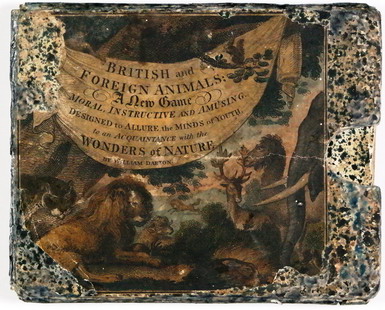 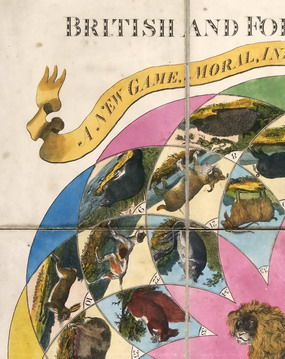 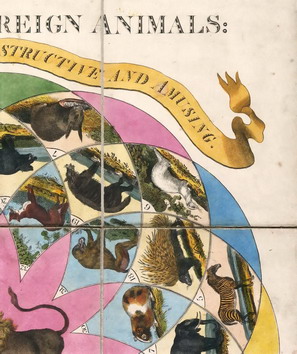  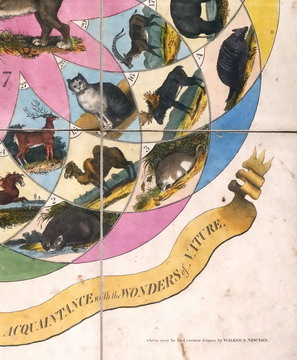 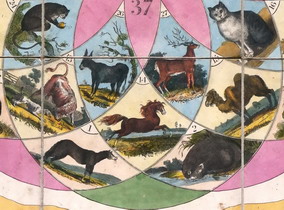 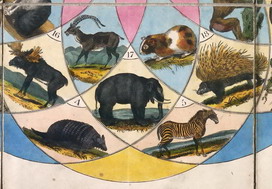 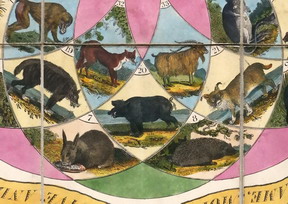 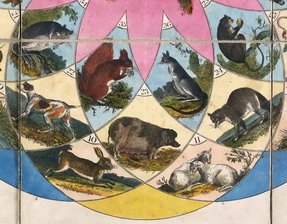 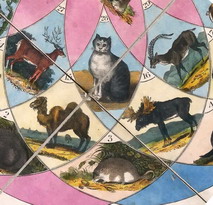 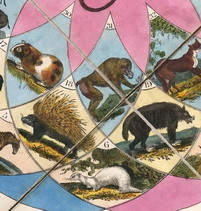 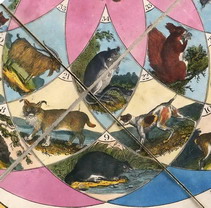 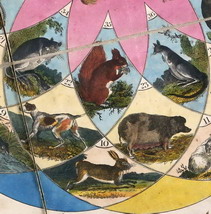 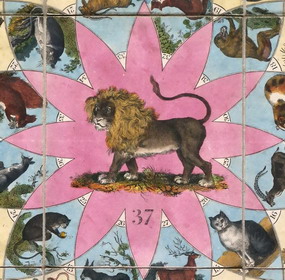 |
primo autore: | Anonimo |
| secondo autore: | Darton William | |
| anno: | 1820 | |
| luogo: |
Inghilterra-Londra |
|
| periodo: | XIX secolo (1°/4) | |
| percorso: | Percorso di 37 caselle numerate | |
| materiale: | carta incollata su tela (engraving on paper with linen backing) | |
| dimensioni: | 492X400 | |
| stampa: | Litografia colorata a mano (hand-coloured engraving | |
| luogo acquisto: | ||
| data acquisto: | ||
| dimensioni confezione: | ||
| numero caselle: | 37 | |
| categoria: | Mondo animale e vegetale | |
| tipo di gioco: | Gioco di percorso | |
| editore: | Darton William, 58 Holborn Hill, London | |
| stampatore: | Darton William | |
| proprietario: | Collezione A. Seville | |
| autore delle foto: | A. Seville | |
| numero di catalogo: | 1371 | |
| descrizione: |
Gioco di 37 caselle numerate. REGOLE: non riportate sul tavoliere. CASELLE: mute. REFERENZA 1 "British and Foreign Animals". (V&A Museum ). The game is described as 'designed to allure the minds of youth to an acquaintance with the wonders of nature'. The playing surface has 37 playing spaces each containing an animal. The game is played with a teetotum spinner marked on eight sides. The animals featured include the otter, armadillo, beaver, sheep, rat, lynx, monkey and fox. The end of the game is marked by the lion, the king of all the beasts. The game comes with a booklet which describes each animal at length and both domestic and wild animals are discussed. Physical description Design: etching, coloured by hand; kaleidoscopic shape of 37 medallions of various shapes, each containing an animal N°of squares: 37 Squares illustrated: all Square numbering: all Squares titled: all Subject of starting square: Jackal Subject of ending square: Lion Place of Origin: London Date: 1820 Artist/maker: Darton, William Materials and Techniques: Hand-coloured etching, mounted on linen Dimensions: Length: 49.2 cm; width: 40 cm Object history note: card slipcase with coloured engraving Historical context note Rewards: EXTRA TURNS AND FORWARD MOVEMENT Forfeits: MISSED TURNS AND BACKWARD MOVEMENT N°of Players: 1-3 OR 6 Equipment required: pyramid/marker and 4 counters for each player; teetotum Rules: Explanation or Key to BRITISH AND FOREIGN ANIMALS DIRECTIONS Two or three persons may amuse themselves with this agreeable pastime; and if a double set of counters and pyramids are purchased, six persons may play at it. The Totum must be marked one to eight, on its several faces with a pen and ink, or with a pencil. You may begin the game agreeably to the following RULES. 1. Each player must have a pyramid, and four counters of the same colour. II. Spin for first player, the highest number to begin the game. III,. Let the first player spin, and place his or her pyramid on the game according to the number turned up. The others, in turn, are to do the same, referring to the Explanation or Key for a description of the Animal. IV. At each following spin, add the number turned up to that on which the pyramid stands, and proceed accordingly, till some one arrives at No. 37 I The Lion), who wins the game. V. Whoever goes beyond No. 37, shall go back as many as he exceeds it and try again when his turn comes. VI. when directed to stop one or more turns, the player is to place so many counters on his number, and take one up each time, instead of spinning till all are redeemed. 1. THE JACKAL In the torrid regions of Africa and Asia, these active and rapacious beasts supply the place which is occupied in temperate and frozen districts by the wolf. The hotter the climate, the greater is their strength and vigour. They collect together, and hunt their prey, in packs of from forty to fifty in number, and attack and devour all kinds of animals. In the burning plains of Egypt and Arabia, they follow the caravans, for the purpose of feeding on whatever is left behind. The lion and the panther oftentimes lurk in the rear of the jackals, and as often rob them of at least part of their prey; hence appears to have arisen the erroneous notion of the Jackal being the lion's provider. These animals live in burrows, which they dig under the surface of the ground; and from which they seldom issue, except during the stillness of the night. Their howling, when in pursuit of prey, is said to be dreadful. If caught young, they may be rendered perfectly tame and domestic. Like a dog, they distinguish their master from every other person, eat out of his hand, and love to be fondled and patted. In many respects the jackal has a great resemblance to the fox. Although it is one of the most numerous of all the wild animals of the East, there is scarcely any one less known in Europe, or more confusedly described by natural historians. They vary in size. Those of the warmest climates are said to be the largest. Nothing can escape their rapacity. They will ransack the repositories of the dead, and greedily devour the most putrid bodies. They are said to attend caravans and to follow armies, in hopes of being furnished with a banquet by disease or battle. They may be considered as the vulture among quadrupeds; and like that destructive bird, devour every thing indiscriminately that his once had animal life. The descriptions follow in like manner and many of the illustrations order movement with in the game. Some of these are hand written (those marked * 2. THE COMMON OTTER, SPIN AGAIN* 3. THE DORMOUSE, LEST THE PLAYER SLEEP OVER THIS DROWSY ANIMALS, LET HIM PASS TO NO. 35. 4. THE SIX BANDED ARMADILLO. STOP ONE TURN* 5. THE ZEBRA 6. THE FERRET 7. THE RABBIT. STOP ONE TURN 8. THE HEDGEHOG. GO ON TO NO. 16* 9. THE BEAVER. HERE STOP ONE TURN, TO EXAMINE THE CURIOUS HABITATIONS DESCRIBED. 10. THE HARE. SPIN AGAIN* 11. THE SHEEP. STOP ONE TURN.* 12. THE RAT. 13. THE BULL. STOP TWO TURNS 14. THE HORSE. SPIN AGAIN, FOR A RIDE ON ONE OF THESE NOBLE ANIMALS. 15. THE CAMEL. GO ON TO NO. 20* 16. THE ELK. STOP ONE TURN.* 17. THE ELEPHANT. SPIN AGAIN* 18. THE PORCUPINE. STOP ONE TURN TO REFRESH. 19. THE HYAENA. 20. THE WILD BOAR. STOP ONE TURN, TO TAKE BREATH AFTER THE DANGEROUS HUNT. 21. THE LYNX. GO BACK ONE TURN LEST THE PIERCING EYE OF THIS ANIMAL DISCOVER YOUR FOIBLES22. THE POINTER. MOVE ON TO 26*. 23. THE SOW 24. THE RACOON. BEGIN AGAIN* 25. THE MONKEY. MOVE ON TO NO. 31 AND SEE WHICH YOU LIKE BEST. 26.THE ASS. SPIN AGAIN*. 27. THE STAG. STOP ONE TURN.* 28. THE CAT. STOP ONE TURN TO ADMIRE BLACK TOM* 29. THE IBEX. 30 . THE GUINEA PIG 31. THE BABOON 32. THE FOX. STOP TWO TURNS TO ELUDE THE TRICKS OF THIS WILY ANIMAL 33 . THE GOAT. 34. THE JERBOA. STOP ONE TURN* 35. THE SQUIRREL. 36. THE KANGAROO. GO BACK TO 26*. 37. THE LION *The 56 page booklet describes each animal at length and furnishes the player with many facts that still hold true today. Both domestic and wild animals, from all continents including Australia (the Kangaroo) are discussed. Some directions for play and the forfeits and rewards are given in the text, but it appears that the publisher's overwhelming desire was to instruct children. Rules placement: booklet Descriptive line: Hand coloured board game, British and Foreign Animals, published in England by William Darton in 1820 Attribution Note: Where may be had various games by Walker & Newton. REFERENZA 2 "Edité par William Darton en 1820, British and Foreign Animals (Les animaux anglais et étrangers) est peut-etre l'un des meilleurs jeux d'histoire naturelle; son sous-titre est "Un nouveau jeu, moral, instructif et amusant, créé pour ouvrir les esprits de la jeunesse vers la connaissance des merveilles de la nature". Le livret de 56 pages décrit chaque animal en détail et donne aux joueurs de nombreux faits qui sont encore vrais aujourd'hui. On peut y trouver des animaux domestiques et sauvages de tous les continents, meme le kangourou australien. Certains instructions pour le jeu, les gages et les récompenses sont donnés dans le texte, mais il semble que le plus grand désir de l'éditeur était d'instruire les enfants. La gravure peinte à la main est montée sur du lin. Lorsque l'on ne se servait pas, le jeu était plié et rangé avec son livret d'instruction, qui est daté 1820, dans un coffret en carton portant une étiquette gravée très sophistiquée." (GOODFELLOW Caroline) REFERENZA 3 "Published in 1820 by William Darton is perhaps one of the best games about natural history, British and Foreign Animals, which has the subtitle "A New Game, Moral, Instructive and Amusing, designed to allure the Minds of Youth to an Acquaintance with the Wonders of Nature". The 56 page booklet describes each animal at lehgth and furnishes the player with many facts that still hold true today. Both domestic and wild animals, from all continents, including Australia (the Kangaroo) are discussed. Some directions for play and the forfeits and rewards are given in the text, but it appears that the publisher's overwhelming desire was to instruct children. The hand-coloured engraving of the game was mounted on linen. When not in use, the game was folded up and placed together with its descriptive booklet, which is dated 1820, in a cardboard slip-case which bears a very elaborate engraved label". (GOODFELLOW Caroline) |
|
| bibliografia: |
1) GOODFELLOW, Caroline: "Jeux de société. Le guide du collectionneur des jeux de société depuis le XVIIIe siècle jusqu’à nos jours", (Edizione francese) Carrousel MS, 2001. 2) GOODFELLOW, Caroline: "A Collector's Guide to Games and Puzzles" Secaucus, New Jersey, Chartwell Books-London, Quintet Publishing Limited 1991. 3) GOODFELLOW, Caroline: "The Development of the English Board Game, 1770-1850", in Board Games Studies 1, 1998. 4) WHITEHAUSE, F.R.B.: "Table Games of Georgian and Victorian Days", London, Peter Garnett, 1951. |
|
| "The Development of the English Board Game", 1770-1850 (Caroline G. Goodfellow) | ||
Vai alla ricerca giochi Vai all'elenco autori